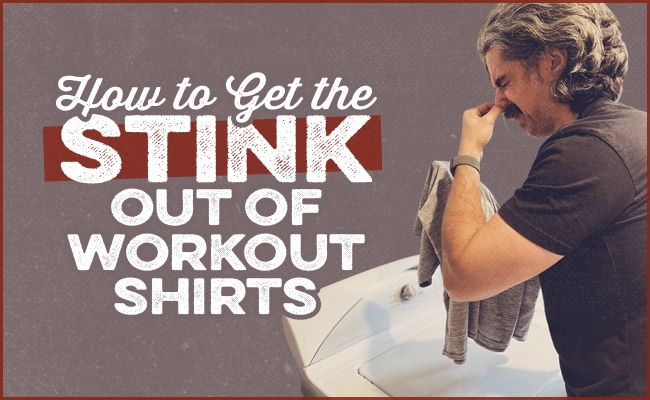
Synthetic workout shirts were supposed to represent a great leap forward in performance wear.
Unlike cotton shirts, which soak up your sweat and become wet and heavy, synthetic fabrics, typically made of polyester, wick away moisture, keeping you cool and dry.
Unfortunately, this advantage comes with a significant downside: they can smell terrible. Terrible. This isn’t just anecdotal observation: sweaty synthetic shirts have been scientifically proven to smell worse than sweaty cotton ones.
There’s something special about the way body odor mixes with polyester that makes for a particularly repugnant scent.
While polyester repels water, it attracts bodily oil and the smelliest kind of bacteria. And while this stinky grime doesn’t get pulled into the fibers of synthetic fabric, it winds up trapped between them, where it becomes stubbornly hard to remove.
This is why your synthetic workout shirt can still smell even after you’ve put it through the wash. And why even if it doesn’t smell coming out of the dryer, it almost instantly starts to stink again when you begin your next workout. The bacteria was never fully washed away in the first place and got reactivated as soon as you started to sweat. This phenomenon is evocatively known as the “rebloom effect.”
Your regular wash routine isn’t sufficient to get the stubborn stink out of synthetic workout shirts. It requires a special HIIT-level effort.
If you prefer to wear synthetic shirts when you work out, but don’t want to knock over fellow members of your running club with your odor, here’s the field-tested cleaning method we recommend:
Buy a week’s worth of workout shirts. Washing your workout shirts requires a special, and especially aggressive, method that isn’t needed or desirable for your other clothes. So you’re going to be washing your workout shirts in their own dedicated wash. Given that you don’t want to do this special wash every few days, buy a week’s worth of workout shirts to batch this chore. This doesn’t have to be a pricey investment: all synthetic shirts pretty much function the same, so you don’t need to get a name brand; even Amazon Essentials’ shirts (2 for $18) work fine. Getting inexpensive shirts will also help you feel better about engaging in the aggressive wash method outlined below.
Keep your dirty shirts in their own ventilated hamper. Because moisture breeds bacteria, experts often recommend hanging up your dirty workout shirts after you take them off to give them a chance to dry out. But the average person is not going to hang up their sweaty workout tops. It still isn’t a good idea to crumple them up in a plastic hamper, though, where their moisture will molder, and their stink will get on your other clothes. So adopt a compromise position: put dirty shirts in a well-ventilated mesh hamper where they’ll at least get some air. Drape your most recently used ones over the outside edges of the hamper so they can get max airflow and dry out faster.
Turn your shirts inside out before washing. This will maximize contact between the shirts’ most soiled areas and the water and detergent.
Use the washer’s heavy-duty hot-water cycle. The manufacturers of workout clothes recommend washing their garments in cool water and drying them on low heat in order to preserve their structural integrity. They warn that hot washing/drying can damage their shirts — causing them to shrink, stretch, or lose their shape. So if you wear expensive, premium workout gear, you may want to heed this warning and treat your shirts delicately.
However, we’ve found that even when using a special detergent designed for workout clothes, a cool cycle just isn’t as effective for stink-removal as a hot one, and a hot wash/dry doesn’t seem to do much damage to synthetic shirts. They still last for years and years. Plus, if you’re already wearing the bargain kind, you may not care if their longevity is slightly diminished.
Set the washer to the hot heavy-duty cycle + presoak + extra rinse.
Don’t overdo the detergent. You might think that using extra soap will make the wash extra effective at removing grime. But using too much detergent will actually backfire, as it creates residue that traps more of the odor-causing bacteria in your shirts. With doing laundry generally, you can often use 30-50% less detergent than the detergent manufacturer calls for and still have your clothes come out clean. So when you’re washing your workout shirts, rather than using more detergent than the bottle suggests, use a little less.
There are special detergents made for washing workout clothes, but we’ve found that a standard detergent works fine, as long as you pair it with the next step:
Presoak the shirts with OxiClean. OxiClean is the secret sauce in getting the stink out of workout shirts. Depending on load size and level of shirt-stink, add a half to full scoop and let soak for four hours. You can soak longer, but then the hot water will cool before the wash cycle starts; you want to strike a balance between soak time and maintaining water temp.
As mentioned above, use the extra rinse function on your washer with this wash to better eliminate residual grime, detergent, and OxiClean.
Dry on high heat. Again, the manufacturers of synthetic workout shirts don’t recommend this. But while a hot dry cycle may or may not get hot enough to kill bacteria outright (it depends on the particular dryer), it will ensure your shirts get thoroughly dry and don’t retain residual, bacteria-breeding moisture. And we haven’t noticed any damage in drying workout shirts this way. But if you’ve got nice shirts you’re worried about, dry them on low heat or air dry.
Don’t use dryer sheets. Dryer sheets work by depositing a softening, static-reducing chemical compound on your clothes. This coating not only reduces the moisture-wicking ability of synthetic shirts but also traps odor-causing bacteria in the fabric.
Instead of using dryer sheets, we use these wool balls in all our loads. They don’t reduce static to the same degree as dryer sheets, but their natural nature, reusability, and workout-shirt-compatibility are a plus.
Whew, just considering all these steps feels like a workout in itself. You might want to make peace with those soggy cotton tees, after all.







![The Santa Claus Workout [VIDEO]](https://content.artofmanliness.com/uploads/2013/12/reins.png)